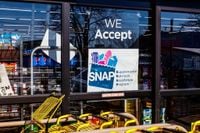Every morning, as the doors of the Lord’s Pantry in Albany, Georgia swing open, a line of people—parents, retirees, the homeless—waits for a chance at a meal. Some are newcomers, forced by rising costs and shrinking resources to seek help for the first time. Others are regulars, their lives a delicate balance of social security checks, disability payments, and, crucially, food assistance from the Supplemental Nutrition Assistance Program (SNAP). As the United States faces sweeping changes to SNAP under President Donald Trump’s so-called “One Big Beautiful Bill,” scenes like these are becoming more common across the nation.
Feeding the Valley, a Columbus-based food bank partnering with over 300 agencies across south Georgia—including the Lord’s Pantry—distributed an astonishing 15 million pounds of food in 2024 alone, according to the organization’s CEO, Frank Sheppard. Yet, demand keeps outpacing supply. “Food insecurity rates are still 35% above pre-pandemic levels,” Sheppard told local reporters, pointing out that most food banks now face shortages. The pandemic’s economic aftershocks linger, and the prospect of deep federal cuts is adding a new layer of anxiety.
The numbers are stark. More than 22 million families nationwide are expected to lose some or all of their SNAP benefits, according to the Urban Institute, with over 5 million households projected to lose an average of $146 per month. In Georgia alone, about 20,000 Albany residents rely on SNAP, and statewide, the funding loss could reach $1.49 billion—a 43% reduction, based on projections shared by GOBankingRates and The Commonwealth Fund. Other states face similar or even harsher cuts: New Mexico, West Virginia, Delaware, New Jersey, and Mississippi are all bracing for reductions of over 40% in federal SNAP funding.
For those on the front lines, the impact is already being felt. Mary Lou Chavers, a board member at the Lord’s Pantry, described a surge in demand: “We’ve had more new people this year than we’ve ever had before. A good many of them are working poor, and they just don’t make enough to feed their families.” The pantry, open from 8 a.m. to 10:30 a.m. Monday through Thursday, typically serves at least 90 people each day. Chavers recounted turning away a homeless man who had come back too early for another food box. “I hate to do that,” she said. “Our food is just so low.”
It’s not just the volume of people, but the complexity of their needs. Z Yisrael, a 36-year-old plumber supporting a family of five on one income, called the pantry “a blessing.” Jimmy Sullivan, a 72-year-old with a disability and a history of homelessness, relies on a modest social security check and SNAP to survive. “I draw a social security check each month, but it’s hard to make it on that,” Sullivan said. “Food stamps don’t carry you too far because food prices are so high. A poor man can’t make it.” Sullivan worries about the looming SNAP cuts: “I’m scared to death if they cut food stamps. It’s going to be bad for us old folks. I just keep praying every day.”
The president’s “One Big Beautiful Bill” proposes nearly $300 billion in SNAP cuts through 2034. The bill also introduces a cost-sharing requirement, forcing states to cover between 5% and 25% of SNAP costs starting in 2028, depending on their payment error rates. States with higher administrative errors—whether overpayments or underpayments—will face deeper cuts. For example, Illinois could be saddled with $700 million in additional SNAP costs unless it reduces its payment error rate from 11% to under 6% by August 2026, as reported by Axios. About 360,000 Illinois residents risk losing benefits, and the state’s governor, JB Pritzker, has warned of far-reaching effects on both hunger and the local economy.
The new rules expand work requirements for SNAP recipients, now including able-bodied adults ages 55-64, adults with dependents over 13, and those previously exempt under lower unemployment rates. Exemptions are now limited to counties with unemployment above 10%. Illinois, where 15% of residents—1.9 million people—receive SNAP, is scrambling to comply. Officials are “engaging in a deep dive into each error, identifying new technology to reduce errors, improving training, clarifying policies, and hiring more than 100 additional staff,” according to a spokesperson for Governor Pritzker.
Not everyone agrees on the bill’s intent. “While the state government will be doing everything in its power to lower the so-called error rate, we cannot gloss over the fact that this provision was intentionally designed as a craven mechanism to deny states funding and feed fewer people in need,” said Matt Hill, a spokesperson for Pritzker. On the other side, Republican Rep. Darin LaHood told Axios, “We are incentivizing states to administer the SNAP program more efficiently and effectively, protecting taxpayers and prioritizing limited resources for those who truly need the benefit.”
The changes come at a time when grocery costs have soared—up 31% in the last three years, according to Feeding the Valley’s Frank Sheppard. For food pantries, this means stretching every dollar further. The Lord’s Pantry spends about $5,000 a month on supplies for food and hygiene bags, relying on a small, mostly senior volunteer base. “I’ve seen a decrease in the desire to serve our Lord by serving other people,” Chavers said, expressing concern about the future of their outreach.
In response, Feeding the Valley has launched a Community Hunger Relief Fund, aiming to raise $500,000 by the end of 2025. “This will cause more people to request the assistance of food banks because other benefits and resources have been cut,” Sheppard said. The fund will be used to maintain food inventory, expand meal delivery to children and seniors, and launch a neighborhood market in Columbus, with plans to bring the model to Albany.
“We always consider hunger relief to be a nonpartisan issue,” Sheppard emphasized. “What we say to elected officials is there are a lot of people that are struggling to make ends meet, and they’re not looking for a handout. These are people just trying to get through … these tough economic times. So we just hope that they’ll be conscious of that when they’re making decisions.”
As the nation faces the largest overhaul of food assistance in decades, the front-line stories from Albany to Illinois paint a picture of communities bracing for hardship, but also responding with resilience and compassion. The outcome of these policy changes will ripple far beyond the halls of Congress, shaping the daily realities of millions who depend on a little help to keep food on the table.






